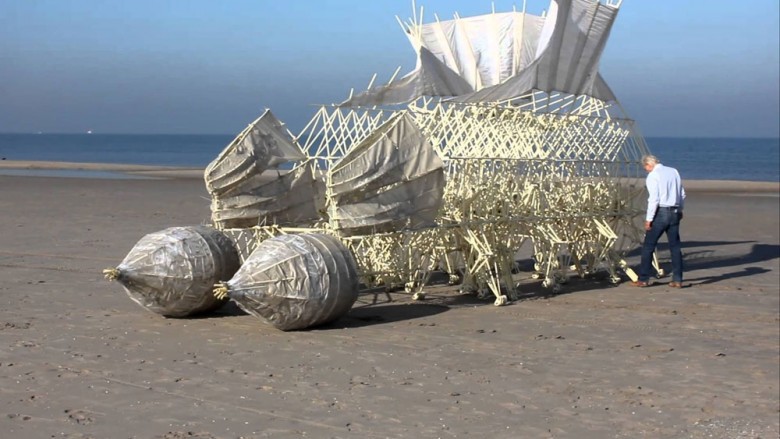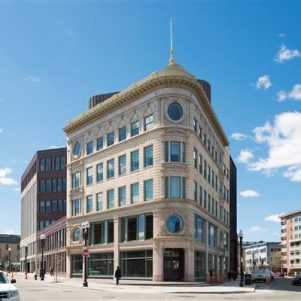Get up close and personal with interactive Strandbeests
By Diane Kilgore | September 18, 2015, 11:15 EDT
 https://www.youtube.com/watch?v=PG2Xv2ivZZU
https://www.youtube.com/watch?v=PG2Xv2ivZZU Theo Jansen introduced Strandbeest to the Peabody Essex Museum in the historic sea port city of Salem, Massachusetts. Now the PEM would like to introduce his “beach-animals” to you. This Saturday, the Museum, recognized by Child magazine as one of the nation’s top 10 museums for kids, hosts an all day family festival and “hack-a-thon” from 10 a.m. to 4 p.m.
Jansen hopes that the Beests, as they are affectionately called, will perpetuate creativity. He sees their sculptural essence as a bridge between art and science. Created from pale yellow PVC tubing, black and white zip ties, white sail cloth and empty lemonade bottles, these enormous, futuristic animals do, indeed, challenge and enthrall at the same time.
From Madrid, to Moscow, to Paris and to Tokyo, the primitive appearance of the Beests elicits an emotional response as they seem to slowly inhale and exhale. As we hear them breathe, their skeletons begin to teeter, stroll, lumber, then rest, only to begin again. Undulating sails use each kinetic wave to store energy inside their stomachs of recycled lemonade bottles.
The Peabody Essex Museum offers visitors the first major American exhibition of the Beests and gives them the opportunity to watch them move with un-choreographed agility; like animated bones of an extinct, now newly imagined reptile.
Inside the PEM, Jansen’s latest, never-before-seen 42-foot-long Animaris Umerus Segundus is pneumatically powered. Sensors in its “simple brain” help the Beest, which appears to be part-velociraptor, part sail-clothed stegosaurus, store wind energy and use sweat glands to remove beach sand from its joints. The enormous Beest breathes, moves towards you, then walks away.
This summer more than 14,000 people visited smaller Strandbeests as they popped up for a stroll around Crane’s Beach, Boston’s City Hall Plaza, the Rose Kennedy Green Way, and the campus of MIT. The museum says these “Dream Machines” “blur the lines between art, science and storytelling.”
A Silver haired, soft spoken artist, Jansen has a degree in physics from the University of Delft and designs new Strandbeest each summer from his workshop in the Netherlands. He beams as he explains how his art is universally accessible. He has found that children and adults around the world experience each marvel of his engineering and seem to “get it” instantly. In fact, his collection of creatures requires no academic interpretation, needs no explanation from an art historian, and no docent is required to explain the “animal.” Each unique dream machine speaks for itself; organically and visually.
Four years ago, Jansen released the algorithmic sequencing or physiology of the Strandbeest via the Internet, hoping ever-evolving herds of Beests will live on years after he passes away. For him, these inanimate forms have the power to mesmerize, inspire empathy and captivate the world with their engineered artificial intelligence. He anticipates practical uses for them to evolve with the art form.
By design, the Strandbeest gallery inside the PEM is interactive with a cool hands-on vibe. Tables are set up with “Beest bones” of PVC piping. Visitors are welcome to pump air pistons and crank zip-tied mechanical joints, teaching without teaching the physics of how the Beests fit together from the inside out. Videos of Jansen explaining his artistic process are strategically placed in the space that looks both ancient and futuristic. Kids of all ages are welcome to walk two full-scale Strandbeests around the exhibition to feel for themselves the magic that transforms ordinary tubing into extraordinary vehicles of imagination.
Trevor Smith, curator of PEM’s “Present Tense” collection, explains the Strandbeest as classical Greek muses with a modern day twist. They embody joyful, playful, creative embers that flicker inside all of us. He sees the message of the Beest as one that can flame the passions of inspiration, not only within artistic geniuses but anyone that dares to feel the stirrings of their own dreams.
Twenty years ago, Jansen allowed himself a year to explore his creative energy. During his 18-hour work days he felt inspired, disappointed, exhilarated and fatigued as he tinkered with tubes hoping they would turn into something larger than life. The “Dream Machines” he had envisioned were to help fill sand bags to protect coastal areas of the Netherlands from raising tides. What evolved through vision and perseverance was a lifetime of “imagineering” that inspires hundreds of thousands of people to wonder what other mysteries may be zip-tied within the anatomy of those bones.
Jansen and the PEM invite you to explore these curious creatures of creativity inside their state of the art gallery and “Release your inner Strandbeest” before they continue their trek across America next year to Chicago and San Francisco.
Peabody Essex Museum: East India Square 161 Essex Street Salem, Massachusetts
Open Tuesday – Sunday and holiday Mondays 10-5
The Standbeests will live at the PEM until Jan. 3, 2016
Diane Kilgore is a Boston-area blogger.










